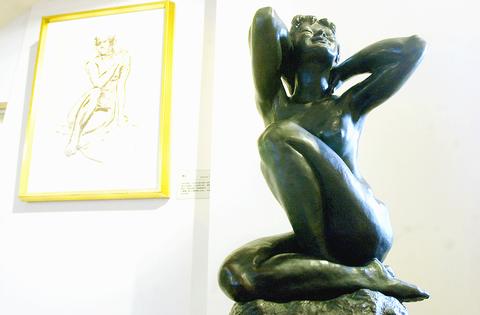Yuyu Yang (
Yang was born in Taiwan and received his education in Japan and Beijing. In Japan, Yang studied under Asakura Fumio (

PHOTO: CHEN CHENG-CHANG, TAIPEI TIMES
In The Dance of Fire (1954), Yang models the figure after the Chinese mythological character of Nu Wa Bu Tian (
Yang's work took him around the world, including to Rome, where he worked and exhibited for three years until 1966. On view in the current show are prints based on sketches he made of the streets of Rome, with that city's picturesque cafes, markets and churches.
Yang's styles changed radically during the different stages of his career. In the 1970s he turned to more streamlined, abstract compositions, two examples of which include Flight (1971) at Singapore's Mandarin Hotel and Wall Street's stainless-steel piece East West Gate (1973). This exhibition, however, emphasizes Yang's earlier, traditional works that laid the foundations for his prolific and ground-breaking career.
Art Notes
What: Naked Women and Streets of Rome: Sculptures and Prints from 1950's and 1960's (楊英風人體雕塑版畫展)
Where: Yuyu Yagn Museum (楊英風美術館), 31 Chungking S. Rd., Sec. 2, Taipei (台北市重慶南路二段31號)
When: Until Aug. 26 (Closed Monday)

This is the year that the demographic crisis will begin to impact people’s lives. This will create pressures on treatment and hiring of foreigners. Regardless of whatever technological breakthroughs happen, the real value will come from digesting and productively applying existing technologies in new and creative ways. INTRODUCING BASIC SERVICES BREAKDOWNS At some point soon, we will begin to witness a breakdown in basic services. Initially, it will be limited and sporadic, but the frequency and newsworthiness of the incidents will only continue to accelerate dramatically in the coming years. Here in central Taiwan, many basic services are severely understaffed, and

Jan. 5 to Jan. 11 Of the more than 3,000km of sugar railway that once criss-crossed central and southern Taiwan, just 16.1km remain in operation today. By the time Dafydd Fell began photographing the network in earnest in 1994, it was already well past its heyday. The system had been significantly cut back, leaving behind abandoned stations, rusting rolling stock and crumbling facilities. This reduction continued during the five years of his documentation, adding urgency to his task. As passenger services had already ceased by then, Fell had to wait for the sugarcane harvest season each year, which typically ran from

It is a soulful folk song, filled with feeling and history: A love-stricken young man tells God about his hopes and dreams of happiness. Generations of Uighurs, the Turkic ethnic minority in China’s Xinjiang region, have played it at parties and weddings. But today, if they download it, play it or share it online, they risk ending up in prison. Besh pede, a popular Uighur folk ballad, is among dozens of Uighur-language songs that have been deemed “problematic” by Xinjiang authorities, according to a recording of a meeting held by police and other local officials in the historic city of Kashgar in

It’s a good thing that 2025 is over. Yes, I fully expect we will look back on the year with nostalgia, once we have experienced this year and 2027. Traditionally at New Years much discourse is devoted to discussing what happened the previous year. Let’s have a look at what didn’t happen. Many bad things did not happen. The People’s Republic of China (PRC) did not attack Taiwan. We didn’t have a massive, destructive earthquake or drought. We didn’t have a major human pandemic. No widespread unemployment or other destructive social events. Nothing serious was done about Taiwan’s swelling birth rate catastrophe.